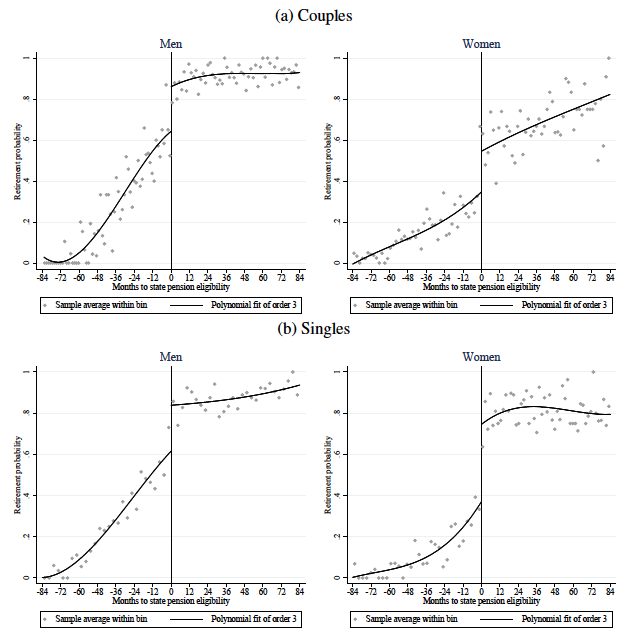In many European countries, the standard retirement age is on the rise. Early retirement programmes are disappearing as a result of weakened sustainability within the pension system, induced in part by the increasing number of inactive retired people. As a result, there are growing doubts about the health consequences for workers who may have to stay in the labour market longer than they anticipated. If retirement improves health, postponing retirement may not be welfare-improving. However, whether this is the case is an open issue.
Empirical studies have presented contrasting results, as summarised by the recent reviews by Van der Heide et al. (2013) and Nishimura et al. (2018). The choice of the estimation method is the key factor in explaining these differences. Unveiling the causal effect of retirement on health is not a straightforward task. One of the central challenges to this study is reverse causality (for example, people in poor health may be more likely to retire at an earlier stage). There is also the issue of unobserved characteristics which can further corrupt the results. Characteristics such as individual preferences for leisure time might determine both the retirement decision and health conditions, obscuring the genuine causality of the overall results. With longitudinal datasets, the latter issue can be removed by introducing individual fixed effects. However, this does not deal with reverse causality or time-varying heterogeneity, such as changes in the grand-parenthood or in other family circumstances.
To overcome these issues, two methods are generally used: instrumental variables (IV) and regression discontinuity design (RDD). Eligibility ages for early retirement or retirement-related social security benefits are popular variables to introduce for the IV methodology. The RDD method typically exploits the sudden increase in the retirement probability as soon as an individual attains the age for pension eligibility. In single-country studies, the identification usually exploits discontinuities in the pension eligibility ages using the RDD method. Studies with data on multiple countries typically use the cross-countries differences in pension retirement ages as exogeneous information to explain retirement decisions (for an overview of the recent literature on the health effects of retirement, see van Ours 2019).
Our study
Studies investigating the health effects of retirement usually focus on mental health because this seems more likely to be immediately affected by retirement. In comparison, physical health conditions change more gradually following retirement. In our study (Picchio and Van Ours 2019), we also chose to focus on the mental health effects of retirement. We make use of data for a single country, the Netherlands, and we use a fuzzy RDD approach to unveil the casual effect of retirement on mental health. The Netherlands is an interesting case study for at least two reasons. Early retirement programmes are quickly vanishing in the country and employment rates among older workers are relatively high. Furthermore, the Dutch typically retire at the age at which they become entitled to the state pension, which has increased from 65 years in 2013 to 66 years and 4 months at the time of writing. In theory, individuals are not obliged to retire at the state pension age, but many workers do so, whether this is their preference or not. Many collective labour agreements dictate that workers lose the entitlement to their job on the day they reach the state pension age. Consequently, when people cross the state pension eligibility age, a sudden jump in the retirement propension is observed in the data. In our study, we exploit this strong discontinuity to instrument the retirement decision and solve for its endogeneity in a fuzzy RDD framework.
Our study further contributes to the literature by investigating the spillover effects between partners. We explore the possibility that the retirement of one partner can potentially affect the mental health of the other, in addition to affecting the welfare of the person leaving work. Moreover, we focus on heterogeneities in the effect of retirement on mental health by focusing on gender and marital status, assessing both partnered and single individuals.
Our data and identifying information
The empirical analysis in our study was conducted using the Longitudinal Internet Studies for the Social Sciences (LISS) panel, collected and administered by CentERdata of Tilburg University. The data are a representative sample of households drawn from the population register by Statistics Netherlands. Background information on general characteristics such as demography, family composition, education, labour market position, retirement status, and earnings is measured on a monthly basis, from November 2007 onwards. We use this monthly information to derive the age (in months) and the retirement status of the subject and calculate how far an individual is from becoming eligible for the state pension. We define an individual as retired if she indicates ‘pensioner’ as her primary occupation. Therefore, retirement is not necessarily from employment but could also be from unemployment. In the LISS panel, ten core studies are carried out once a year, surveying individuals on a wide set of topics including health, religion and ethnicity, social integration and leisure, work and schooling, personality, politics and economic situation. We use the core study on health to get measures of mental health and we link these to the monthly information on age and retirement status. Our final sample spans from 2007 until 2017.
Figure 1, taken from Picchio and van Ours (2019), reports the probability of retiring as a function of the months to state pension eligibility by splitting the sample by gender and marital status. It shows the discontinuities we exploit in our fuzzy RDD. As soon as individuals become eligible for the state pension, the probability of retirement suddenly increases by 20 percentage points or more.
Figure 1 Discontinuity in the retirement probability
Our findings
Our dataset contains a set of variables which describe mental health under different perspectives. In order to concentrate our focus on mental health wellbeing, we use the five-item Mental Health Inventory as outlined in Berwick et al. (1991). We also enrich the picture by looking at separate components of mental health, including measures such as happiness, calmness, anxiety, depression, and feeling down. We also investigate how retirement affects self-perceived health. We separately estimate the retirement effects by gender and, for individuals living in a couple, we estimate the effect of retirement on both the individual’s own health and the health of the partner.
Figure 2 summarises our main findings. The left panel displays the retirement effect on the probability that an individual is in good mental health. The right panel reports the retirement effect on the probability that an individual reports being in good or excellent health.
Figure 2 Retirement effect on mental health and self-reported health
In the context of couples, when men retire mental health improves substantially and significantly for both the retiree and his partner. The probability of being in good mental health increases by almost 25 percentage points for the retiring individual, and by approximately 20 percentage points for his partner. The retirement of a woman has a much less substantive effect on the retiree’s mental health or on the health of her spouse. We uncover similar findings when we focus on the individual components of mental health, such as depression or feeling down. For partnered women, retiring appears to be less of an obvious issue in terms of mental health implications. Of course, this may be related to the ‘net drop’ in working hours for working women. On average, this change is far more substantial for retiring men than it is for retiring women, thus magnifying the impact.
For single women, the retirement effects are similar to those of partnered women. However, our results for single men sometimes differ substantially from those of partnered men and women. Single men who retire experience a drop in overall mental health wellbeing of about 40 percentage points; the results for self-perceived health are very similar. Additional analysis focusing on leisure time and on feelings of loneliness sharpens the picture. The results suggest that satisfaction with the quantity of leisure time increases across the board, but feelings of loneliness increase for retiring single men while decreasing for retiring partnered men. As a result, increasing the state pension age might have positive effects on the health and happiness of single workers, because it can prevent feelings of loneliness from becoming a major mental health problem for these individuals.
Conclusions
There is an inherent heterogeneity in the retirement effects according to gender and marital status, and this means that it is difficult to draw uniform policy conclusions. As illustrated, for partnered men, retirement appears to have positive mental health effects. In contrast, the mental health effects are often negative for single men. Many collective labour agreements do not take this heterogeneity into account as they indiscriminately dictate that workers will lose their job on the day they reach the state pension age. By considering the differences in mental health wellbeing and the heterogenous effects of retirement on self-assessed health, we conclude that allowing for greater overall flexibility in the retirement process would have welfare-improving effects.
References
Berwick, D, J Murphy, P Goldman, J Ware, A Barsky and M Weinstein (1991), “Performance of a five-item mental health screening test”, Medical Care 29(2): 169–176.
Mazzonna, F and F Peracchi (2017), “Unhealthy retirement”, Journal of Human Resources 52(1): 128-151.
Nishimura, Y, M Oikawa, and H Motegie (2018), “What explains the difference in the effect of retirement on health? Evidence from global aging data”, Journal of Economic Surveys 32(3): 792-847.
Picchio, M, J C van Ours (2019), “The Mental Health Effects of Retirement”, CEPR Discussion Paper No. DP14135.
Rohwedder, S and R J Willis (2010), “Mental retirement”, Journal of Economic Perspectives 24(1): 119–138.
Van der Heide, I, R van Rijn, S Robroek, A Burdorf and K Propper (2013), “Is retirement good for your health? A systematic review of longitudinal studies.” BMC Public Health 13(1): 1180.
Van Ours, J C (2019), “Health economics of the workplace: Workplace accidents and effects of job loss and retirement”, in Oxford Encyclopedia of Health Economics, Oxford University Press.






